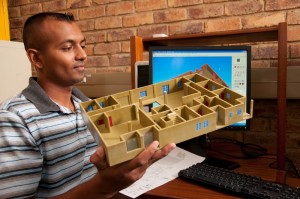 CSIR clients benefit from a specialist capability that allows one to take a design, capture and simulate it digitally – and produce an actual, tangible object in hand. Previously known as rapid prototyping, direct manufacturing has changed the manner – and speed – at which a design can be turned into a physical prototype or model.
CSIR clients benefit from a specialist capability that allows one to take a design, capture and simulate it digitally – and produce an actual, tangible object in hand. Previously known as rapid prototyping, direct manufacturing has changed the manner – and speed – at which a design can be turned into a physical prototype or model.
The CSIR’s research area, Technology for Special Operations (TSO) focuses on technology solutions to address the unique requirements of the Special Operations cadres within the South African National Defence Force. In this field, rapidly created, custom and efficiently-working solutions are critical. Direct manufacturing technology is now considered mature and cost effective enough to be a strong extension to the TSO capability.
CSIR 3D printer offers unique capabilities
Direct manufacturing comprises of stereo-lithography apparatus (SLA) where a laser sets a layer of wax or photosensitive material in a bath; three-dimensional printing (3DP), which uses injection technology to create a thermo plastic structure; and selective laser sintering (SLS) that uses a laser to fuse powders, such as nylon, polycarbonate, polymer and metal.
None of these, however, can be used for colour terrain models. For this reason, the CSIR procured a 3D printer that uses colour ink jet technology, which works like the normal printer one would use to print a photograph, except that it does not print one layer per sheet of paper. It prints layer after layer, using a material that builds up on the previous layer of material. Each layer is a ‘picture’ that slices through the object.
A frequent use of this printing capability is for the final production of 3D terrain products, based on the input data from TSO’s Geographical Information Systems (GIS) experts, clearly showing all aspects of a terrain, as well as any specific information required by the client, in colour.
The input into the 3DP can be created in computer aided design (CAD) software or by using a 3D scanner to capture all dimensions of a particular object or shape.
CAD has for many years been able to turn the designer’s design into a computer model that can be viewed on a computer. This has aided the design process significantly and direct manufacturing allows the designer to be able to produce a complex model quickly and affordably. This also enhances the advanced mechanical engineering capability within the CSIR, especially when complex mechanical engineering solutions are required. The technology thus has obvious benefits in terms of saving time, as well as reducing material waste, associated with conventional forms of manufacturing, lower energy use, and allows for the design of unusual and more organic shapes and forms.
The designer can use direct manufacturing to produce scaled models of actual structures, terrains, areas, prototypes of parts, and as a high-production volume input to investment casting (for patterns), injection moulds (for hard tooling), sand moulds (for cores), and soft tooling (for cores).
The CSIR’s intention is to expand the current rapid prototyping capability to include direct manufacturing technology and welcomes those who want a tangible version of their designs as a prototype, a test version or basis for any other more creative design. TSO is eager to create a shared direct manufacturing capability and service, including training, within the CSIR and with its clients.
